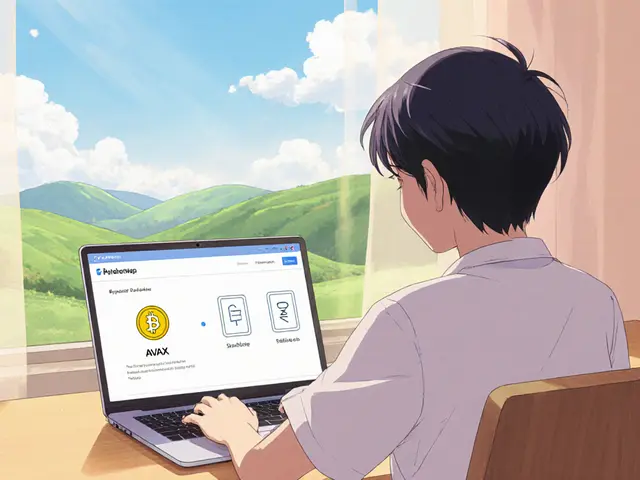22
Norway’s Crypto Mining Data Center Restrictions: Rules, Ban & Registration

Norway Crypto Mining Compliance Checker
- 1 All crypto-mining data centers must register with Nkom by July 1, 2025
- 2 New high-energy facilities (above 2 MW) are banned starting autumn 2025
- 3 Non-compliance can result in fines up to 5% of annual turnover
- 4 Existing facilities can continue but cannot expand without permission
Enter your details and click "Check Compliance Status" to get a personalized compliance report.
- Submit Nkom registration by July 1, 2025
- Document energy forecasts for future thresholds
- Consider renewable energy certifications
- Explore alternative jurisdictions like Iceland or Sweden
TL;DR
- From Jan12025 Norway requires every crypto‑mining data center to register with Nkom.
- A temporary ban on *new* high‑energy mining facilities starts in autumn2025.
- Non‑compliance can cost up to 5% of annual turnover.
- Existing miners get a transition period until July12025 to meet registration.
- Operators are shifting to Iceland, Sweden or North America to avoid the restrictions.
What the new framework actually does
Norwegian cryptocurrency mining data center restrictions are a two‑part legal package introduced to curb power‑hungry crypto mining. The first part, the Norwegian Electronic Communications Act (effective 1Jan2025), creates a national registry for all data‑center operations. The second part is a temporary prohibition on constructing any new mining‑focused facilities that exceed a yet‑to‑be‑publicized energy‑use threshold.
Two government bodies enforce the system: the Norwegian Communications Authority (Nkom) runs the registration portal, while the Ministry of Digitalization and Public Administration and the Ministry of Energy set the policy direction. Ministers Karianne Tung (Digitalisation) and Terje Aasland (Energy) are the public faces of the crackdown.
How registration works
Every operator must submit a digital form before construction begins or, for existing sites, by 1July2025. The form asks for:
- Company name and legal status.
- Physical address of the facility.
- Designated point‑of‑contact for government communications.
- Full service catalogue - and a specific line for "cryptocurrency mining" if that service is offered.
- Customer list, split between public agencies and private enterprises.
Failure to register triggers fines up to 5% of the operator’s annual turnover. The penalty is calibrated to make non‑compliance financially unattractive, especially for mid‑size miners that run on thin margins.
Temporary ban on new mining data centers
Announced in April2024 and kicking in during autumn2025, the ban targets only *new* facilities that plan to use the most power‑intensive ASIC rigs. Existing sites can keep running but cannot expand capacity or start fresh projects without explicit permission.
Minister Tung summed up the rationale: “We want to limit crypto mining as much as possible because it consumes a lot of electricity while creating few jobs.” Energy Minister Aasland added that the same electricity could be redirected to manufacturing, public services, or other industries that generate higher social returns.
Because the exact megawatt‑per‑hour threshold is still unpublished, many borderline operators are waiting for clarification before committing capital.

Impact on miners and the broader market
The registration cost itself - legal counsel, documentation, ongoing reporting - can run into tens of thousands of euros for a modest operation. Smaller hobbyists are finding the paperwork overwhelming and are either shutting down or moving to jurisdictions with lighter rules.
At the same time, larger mining firms with existing Norwegian assets are negotiating extensions and seeking to prove that their energy mix (almost 100% hydroelectric) aligns with the country’s climate goals. Some have proposed adding “green‑hash” certifications to argue for exemptions.
Internationally, the ban has sparked a noticeable shift. Companies that had earmarked Norway as a renewable‑energy haven are now eyeing Iceland’s cheap geothermal power, Sweden’s surplus wind, or North‑American sites in Texas and Alberta that also boast abundant renewables. This regulatory arbitrage is reshaping the regional hash‑rate distribution, concentrating more mining power outside the Nordics.
How Norway’s approach compares to its neighbours
| Country | Regulatory stance | Power cost (€/MWh) | Main energy source |
|---|---|---|---|
| Norway | Registration required + temporary ban on new high‑energy mines | ~0.04 (hydro‑rich) | Hydroelectric |
| Iceland | No specific mining restrictions, incentives for low‑carbon sites | ~0.02 (geothermal) | Geothermal & hydro |
| Sweden | Permissive, but must comply with general environmental permits | ~0.06 (mixed) | Wind, hydro, nuclear |
| Finland | Open policy, focus on renewable‑energy contracts | ~0.07 (mixed) | Hydro, wind, nuclear |
Norway is the only Nordic nation that has built a dedicated data‑center registry and imposed a forward‑looking ban. The table highlights why many miners see Iceland as a natural fallback.
Compliance hurdles and legal overlap
Beyond the registration, miners must also navigate the EU‑style MiCA (Markets in Crypto‑Assets) regulation, which Norway is adapting into its national law in 2025. The Norwegian Financial Supervisory Authority (FSA) is already issuing guidance on AML/KYC for crypto‑related services. In practice, a mining operator could end up filing paperwork with three separate agencies:
- Nkom - data‑center registration.
- FSA - financial‑services compliance under MiCA.
- Ministry of Energy - any permits for large‑scale electricity use.
Specialized legal counsel is becoming a de‑facto requirement, pushing up operational costs. Early‑stage startups often lack the capital for such counsel and therefore opt for jurisdictions with a single‑point compliance model.
What’s next? Potential expansion of the rules
Both ministers have hinted that the temporary ban will be reviewed annually. If the energy‑policy balance continues to favor traditional industries, the ban could become permanent and expand to cover upgrades of existing mines.
Environmental groups, however, see Norway’s model as a possible template for other countries with abundant renewable power. The key question will be whether the registration‑plus‑ban framework can be scaled without stifling legitimate digital‑infrastructure growth.
For operators still in Norway, the practical checklist looks like this:
- Submit the Nkom registration form by the July12025 deadline.
- Document all energy‑use forecasts to anticipate the future ban’s threshold.
- Engage a local law firm familiar with both Nkom and MiCA requirements.
- Consider diversification - either by adding “green‑hash” certifications or by planning a phased relocation.

Frequently Asked Questions
Do existing crypto‑mining data centers have to stop operations?
No. Existing facilities can continue to run until the temporary ban expires, but they must complete the Nkom registration by 1July2025. Expansions or new high‑energy projects are prohibited without a special permit.
What counts as a “high‑energy” mining operation?
The government has not published a precise MW threshold yet. In practice, the ban targets facilities that plan to run large‑scale ASIC farms consuming several megawatts continuously. Operators should assume any setup above 2MW will be scrutinized.
How much is the registration fine?
Non‑compliance can be fined up to 5% of the company’s annual turnover, making it one of the steepest penalties in Europe for data‑center operators.
Can I still mine if I use renewable energy?
Renewable energy alone does not exempt you from the ban. The restriction is based on *capacity* and *new construction* rather than the source of power. However, you may be able to apply for an exemption by demonstrating economic benefits to the local community.
What alternatives do miners have?
Many are looking at Iceland, Sweden, or North‑American states with abundant renewable grids. Those jurisdictions typically require only standard environmental permits and have no dedicated crypto mining registry.









katie littlewood
November 22, 2024 AT 14:29The new Norwegian framework might look strict at first glance, but it actually opens a door for smarter, greener mining strategies. By requiring registration, Nkom creates a transparent database that can help operators benchmark their energy use against peers. This transparency encourages collaboration between miners, energy providers, and local municipalities to find win‑win solutions. For instance, mining farms can negotiate power‑purchase agreements that lock in low‑cost hydroelectric rates while guaranteeing steady demand for the grid. Those agreements can be structured to include “green‑hash” certifications that reward operators for using renewable power. The temporary ban on new high‑energy sites pushes developers to think creatively about modular, scalable designs that stay below the undisclosed threshold. Smaller modular units can be deployed incrementally, allowing miners to stay compliant while still expanding capacity over time. Moreover, the seven‑month window to register gives existing facilities a realistic timeline to upgrade reporting tools without scrambling. Many firms are already investing in AI‑driven monitoring platforms that automatically log megawatt usage and generate compliance reports. These tools not only simplify paperwork but also highlight inefficiencies that can be trimmed for cost savings. In the long run, the data collected by Nkom could inform national energy policy, ensuring that excess renewable generation finds productive uses. That would be a major step toward turning Norway’s abundant hydro resources into a catalyst for sustainable digital infrastructure. For operators considering relocation, Iceland’s geothermal bounty and Sweden’s wind farms remain attractive, but Norway still offers the lowest carbon intensity per kilowatt hour. If miners pair that low‑carbon power with robust compliance, they can position themselves as leaders in the emerging “green mining” niche. So while the headline sounds like a ban, it’s really an invitation to innovate, collaborate, and showcase responsible crypto mining on a beautiful, clean‑energy stage.
Jenae Lawler
November 27, 2024 AT 05:35While many herald Norway’s registration mandate as progressive, it undeniably adds another bureaucratic layer that could stifle agile entrepreneurship within the crypto sector. Such top‑down regulation may ultimately push capital toward jurisdictions with clearer, less onerous frameworks.
Chad Fraser
December 1, 2024 AT 20:42Hey folks, if you’re wrestling with the new Nkom paperwork, you’re not alone-lots of miners are in the same boat. The good news is that the forms are actually pretty straightforward once you gather your energy‑use data. I’d suggest setting up a shared spreadsheet with your team so everyone can contribute the numbers without duplication. Plus, reaching out to local hydro providers early can speed up the verification step and maybe even land you a better rate. Keep the momentum going, because once you’re registered you’ll have a solid foundation to scale responsibly.
Jayne McCann
December 6, 2024 AT 11:49The ban just forces miners to move elsewhere, nothing new there.
Richard Herman
December 11, 2024 AT 02:55Norway’s approach is a fascinating case study in how resource‑rich nations balance economic diversification with environmental stewardship. By tying mining permits to renewable capacity, they’re signaling that crypto can coexist with green policy-but only if it plays by the rules. Other Nordic countries are watching closely; Sweden remains more permissive, while Iceland leans into geothermal incentives. For investors, this means a shifting landscape where jurisdictional risk assessments become as important as hash‑rate calculations. Companies that can adapt their operations to meet local compliance will likely enjoy a reputation boost and potentially smoother access to financing. In the end, it’s less about the ban itself and more about the collaborative framework it introduces for sustainable mining.
Parker Dixon
December 15, 2024 AT 18:02Great rundown, Katie! 🙌 If you need a quick template for the Nkom form, I’ve got a Google Docs version you can copy‑paste. Just fill in your MW estimate, annual turnover, and energy source, then hit submit. 🎯 Let me know if you run into any validation errors!
Stefano Benny
December 20, 2024 AT 09:09From a systems‑engineering perspective, the threshold logic resembles a classic capacity‑capped provisioning model. Your modular deployment suggestion aligns with horizontal scaling, but ensure each node’s power envelope stays under the 2 MW benchmark to avoid regulatory flagging. Leveraging load‑balancers can distribute hash work while keeping individual racks within limits. Also, consider integrating real‑time telemetry via SNMP to feed Nkom’s compliance dashboards automatically.
Bobby Ferew
December 25, 2024 AT 00:15Honestly, the whole regulatory circus feels like a power grab that drags the community into endless paperwork. It’s exhausting watching miners scramble over forms instead of focusing on innovation. The fine‑tuning of thresholds seems vague, leaving many to guess their fate. Still, if you can navigate the maze, the hydro advantage remains tempting.
celester Johnson
December 29, 2024 AT 15:22Regulation is the shadow that looms over every pursuit of profit, a reminder that freedom is always conditional. In Norway’s case, the shadow is painted green, but it still eclipses the light of unbridled mining.
Prince Chaudhary
January 3, 2025 AT 06:29Colleagues, the registration deadline is approaching, so prioritize gathering your documentation today. Align with your local energy supplier to verify the MW forecast; this will smooth the approval process. Remember that compliance reflects professionalism and can enhance your standing with partners. Let’s stay focused and meet the July target together.
John Kinh
January 7, 2025 AT 21:35I get the hype, but honestly, adding another layer of red tape just makes the whole thing more tedious. 🤷♂️ If miners are serious, they’ll find a jurisdiction with fewer strings attached.
Mark Camden
January 12, 2025 AT 12:42From an ethical standpoint, any operation that consumes megawatts of renewable electricity must justify its societal contribution. Crypto mining, while innovative, does not inherently produce tangible public goods. Therefore, governments are justified in imposing registration and usage caps to ensure that public resources are not monopolized by speculative enterprises. The Norwegian model, albeit stringent, serves as a responsible precedent. Stakeholders should view compliance not as an obstacle but as a moral imperative.
Evie View
January 17, 2025 AT 03:49The ban is a blunt instrument that smothers competition and favors entrenched energy monopolies. It’s a power play that undermines the very decentralization ethos of crypto. If Norway wants to stay relevant, it should adopt lighter, incentive‑based policies rather than draconian restrictions.
Kate Roberge
January 21, 2025 AT 18:55Oh great, another ‘balanced’ checklist from the Nordics-because we all needed more paperwork, right? Your ‘green‑hash’ idea sounds like a buzzword parade, not a real solution. Honestly, it feels like they’re just moving the goalposts to keep miners on their toes. If you’re already sweating over the 2 MW threshold, good luck convincing regulators that you’re not plotting world domination. Bottom line: it’s a hassle, and you’ll be better off looking elsewhere.
Oreoluwa Towoju
January 26, 2025 AT 10:02A quick tip for anyone filing: double‑check the energy‑source dropdown; selecting ‘hydro’ automatically flags the application for priority review. Also, keep a simple log of monthly consumption to speed up future audits. This small habit can save you hours of back‑and‑forth later.
Jason Brittin
January 31, 2025 AT 01:09Nice hacks, Oreoluwa. 😂 I guess if you’re already dealing with bureaucracy, you might as well make it a sport. Just remember to breathe between form submissions-regulation can be a real cardio session. 💪
Amie Wilensky
February 4, 2025 AT 16:15Indeed-punctuation matters; each clause must be terminated precisely; otherwise, the legal interpretation may falter; this is especially true in regulatory filings; ensure every statement ends with a period; consistency is key.
MD Razu
February 9, 2025 AT 07:22The interplay between sovereign regulation and decentralized technology invites a deeper philosophical inquiry. When a nation asserts control over a globally distributed network, it raises questions about the locus of authority. Is the purpose of crypto to evade jurisdiction, or to coexist within the legal frameworks that govern energy consumption? One could argue that the very act of mining is a form of digital craftsmanship, deserving of protection rather than suppression. Yet, the environmental externalities cannot be ignored; the planet’s climate budget is finite, and energy‑intensive processes must be accounted for. Norway’s policy thus serves as a litmus test for how societies reconcile innovation with stewardship. If miners adapt by integrating demand‑response mechanisms, they demonstrate a willingness to align with communal goals. Conversely, if they relocate en masse, it may signal that current regulatory balances are misaligned with market realities. Ultimately, the outcome will inform future treaties on digital asset governance. We should watch not only the immediate compliance statistics but also the longer‑term evolution of hash‑rate distribution as a metric of ecological responsibility. In this light, regulation becomes not an impediment but a catalyst for sustainable technological evolution.
Charles Banks Jr.
February 13, 2025 AT 22:29Sure, MD, keep the grand philosophical lecture going while the rest of us are just trying to click “Submit.” Your deep‑dive sounds impressive, but I’m more interested in whether the form actually works. If you’ve got a cheat sheet, feel free to share-otherwise, enjoy your monologue.
Ben Dwyer
February 18, 2025 AT 13:35Keep at it, team-every form you file brings us one step closer to a compliant operation. Remember, consistency and attention to detail will pay off when the regulators review your submission. Stay focused and you’ll get through this without a hitch.